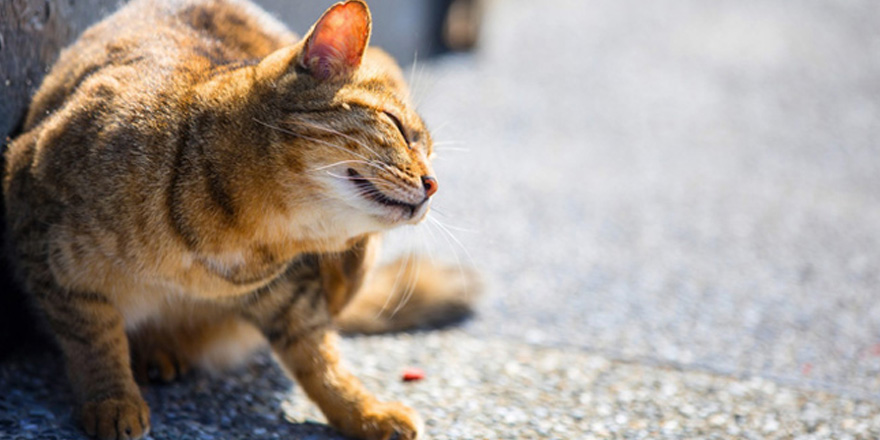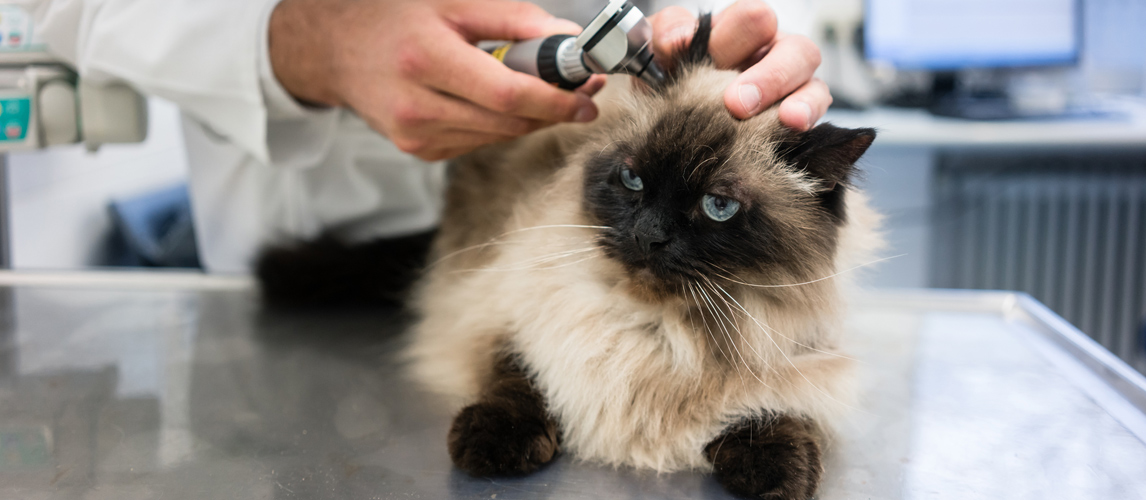Imagine petting your cat one day only to find tiny black creatures scuttling around their ears. Many cat owners would assume that these creatures are fleas, as they’re the most common infestation in household pets. However, if the creatures appear to be focusing their energy around the ear area then it is more like to be ear mites. Ear mite infestations are every cat owner’s nightmare. Cat ear mites can cause infection, hearing loss, irritation, itching, and overall discomfort for your feline friend if not dealt with, therefore you should treat ear mites with caution and urgency.
Once you have figured out that your cat is suffering from an ear mite infestation, you should look to figure out the extent of the problem, and decide on the best course of action moving forward. In more severe cases you may find that the best option is to seek professional veterinary advice. However, it is possible to use natural remedies that can be made at home to clear your cat’s ear mites by either deterring them away from the ear canal or killing them off completely.

What Are Ear Mites?
Scientifically known as Otodectes cynotis, ear mites are tiny creatures (about the size of the head of a pin) that closely resemble spiders or crabs when viewed under the microscope. Owing to their microscopic size, you would barely be able to notice them, the only evidence of their presence is dark-brown and crumbly debris on the inner flap of your cat’s ear. Ear mites themselves are almost invisible to the naked eye but can appear white on a dark background if they catch the light. The debris left behind is a combination of feces, ear wax, and empty eggs.
Cat ear mites are parasitic creatures that feed on ear wax and the natural oils of your cat’s skin. They multiply extremely quickly and live for around 2 months on average. However, once a cat’s ear becomes their nesting ground they can cause a lot of damage and are unlikely to leave without being forced.
How Did My Cat Get Ear Mites?
Most cat owners pose this question when faced with the problem of ear mites. Generally speaking, dogs and cats are particularly susceptible to ear-mite infestation owing to their open protruding ears and some of the possible sources are:
- Outdoor cats exploring in lawns, gardens, barns, and so on.
- Fellow felines, like a mother cat passing ear mites to her kittens or other cats that may act as playmates or companions.
- Through interacting with other animals that are susceptible to ear mites – especially dogs, rabbits, and rodents.
- The build-up of wax in the ears over a period of time becomes a welcome breeding ground for ear mites.
- A general lack of hygiene and maintenance can create a dirty environment in which certain parasites thrive such as mites, ticks, and fleas.
Symptoms of Ear Mites in Cats
The presence of ear mites in cats manifests through several tell-tale signs which could range from simple redness to something more serious and obvious such as discharge and odor coming from your cat’s ears. If you suspect your cat may be struggling with ear mites, look out for the following symptoms:
- Consistent tilting of the head in one direction.
- Excessive scratching at the ear and ear area.
- Progressively worsening or persistent head shaking.
- Redness and inflammation in the ears.
- Increased sensitivity in the affected areas which causes the cat to flinch when being touched (even with a light touch).
- Waxy secretion leaking from the ears – this can sometimes give off a bad odor.
- A powdery build-up in the cat’s ears resembling coffee grounds.
- Crusts or scabs forming in and around the ears.
- Black, dry discharge that can also let off a bad smell.
How to Check for Ear Mites
If you have noticed any of the above symptoms at a distance but would like to investigate further to ensure you’re correct before pursuing a course of treatment or utilizing a remedy, then checking for mites is quite simple.
Ensure the Cat is Calm Before Beginning
Before you even think of approaching your kitty to check their ear canal for mites, you need to ensure they are calm and as comfortable as possible given the circumstances. You may find that using calming cat treats, a calming collar or plugin, or catnip may help to placate them before you begin your examination.
Gently Fold Back the Ear Flap
When checking inside the ear you need to be extremely careful to use as light a touch as possible to prevent further irritation or pain. You will then need to gently fold back the ear flap in order to get a better view of your cat’s ear canal. Cat ear canals are quite wide (hence their susceptibility to developing an ear mite infestation), meaning once you have opened the ear to the light you should be able to see into it quite easily.
Look for Tiny White Specks or a Dark Powdery Substance
Seeing as ear mites are almost invisible, it can sometimes be easier to look for evidence of ear mite activity by looking for mite debris which can resemble a dark powdery substance that will coat the inside of the ear. It is also possible for ear mite debris to appear like pale crumbly wax depending on how they have been living.
Ear mites themselves will look like minuscule white specks amongst the debris. If you spot the debris but can’t spot the mites, it is extremely likely that they are still there, especially if your cat is exhibiting other signs of irritation suggesting they have retreated deeper into the ear canal.
Have them Checked by a Professional if you’re Unsure
Taking your cat to the vet may be the best option if they are acting out against your attempts to check or if you’re not entirely sure what you’re looking at. A vet will use a cotton swab in order to check the debris under a microscope and confirm the existence of ear mites.
Make sure to also check out our article on the best ear cleaners for cats.
Home Remedies for Treating Ear Mites
Now that you have detected the presence of ear mites, it is time to relieve your cat of their presence. Listed below are some home remedies that will help you achieve this objective:
Apple Cider Vinegar Diluted in Water
Apple cider vinegar has earned a reputation for being a somewhat universal ingredient to multiple remedies. It has a variety of health benefits including lowering blood pressure and cholesterol levels as well as killing off bad bacteria (which can help to clear an ear infection).
For the remedy you’ll want to dilute apple cider vinegar with an equal quantity of water, ensuring that the proportion of both liquids in the solution is 1:1. Pour the 50/50 mixture into a spray bottle, being careful to select a spray bottle with a gentle spray setting. Keep the bottle refrigerated between treatments and spray the mixture into your cat’s ear one-three times a day for 10 days.
Be careful not to spray directly down the ear canal as the force of the spray could cause further damage – simply spray the ear from the outside aiming against the flap / towards the ear canal and spray it into your cat’s ears at least once a day for 10 days at a stretch.
ACV is naturally laden with a number of elements and volatile oils that are effective in eliminating parasites and fleas and impeding further growth. Though a few words of caution with this particular method – make sure your cat isn’t allergic to ACV, and be sure to only use this method if the skin is unbroken.
If your cat has been scratching causing lacerations then the acid from the vinegar will cause severe discomfort for your kitty and make future treatment much more difficult as they will likely develop a negative association with the act.
Organic Honey
Using a cotton ball to massage organic honey around the inside of your cat’s ear every day can help to chase away ear mites. Let the honey sit on the ear for around 30 minutes before gently cleaning it away using a fresh cotton bud and some warm water (ideally filtered or boiled and then cooled).
If your cat is willing to allow it, you should aim to repeat this process twice a day until the symptoms subside and all signs of mites are gone.
Garlic with Almond or Olive Oil
Garlic has natural bacteria-killing properties that can help to combat any bacterial infection caused by the presence of mites. Additionally, as we all know, garlic has a particularly pungent scent which often works wonders for repelling insects. However, this same smell can also be overwhelming for your kitty, so look out for signs of stress or discomfort after applying this remedy.
To use this remedy simply grind up some garlic cloves and soak them in almond oil or olive oil for a day or two. Once marinated you need to gently apply the mixture in and around your kitty’s ears using a cotton bud. The antibiotic properties of the garlic should help to soothe irritation in the area and reduce redness.
Effective though this remedy is, it will not work on cats that have a habit of swallowing everything that they lick or cats allergic to either of the two ingredients.

Vaseline
Petroleum jelly, aka Vaseline, is a natural antiseptic and antibiotic, making it an excellent topical option for ear mites. By applying vaseline to your cat’s ear either with a cotton bud or your finger, it should help to reduce swelling, redness, and discomfort. Vaseline can also help to smother the ear mites, either killing them off completely or repelling them away from the ear.
All you need to do is gently massage some Vaseline on your cat’s ears on a daily basis till it is absorbed well. Petroleum jelly can also help to make the removal of mite debris much easier. Just be careful to only use this remedy for ears that are swollen or reddened.
If your cat’s scratching constantly and has caused sores or cuts, it’s better to use a more open-wound-friendly option, as vaseline can clog up the area and potentially exacerbate an already irritating problem.
Aloe Vera
Among its multiple therapeutic properties is aloe vera’s ability to neutralize ear mites and prevent them from returning. You can either directly massage the aloe vera onto your cat’s ears or use a topical aloe vera lotion for achieving the same results.
This is one of the more favored natural home remedies for ear mites in cats due to the fact that is extremely gentle on your cat’s skin and is highly effective at reducing inflammation. With less inflammation comes less pain.
Essential Oils
There are a few essential oils that are highly recommended for parasite problems such as mites, fleas, and ticks (when diluted with carrier oils such as coconut or olive oil) owing to their anti-inflammatory and antibacterial properties:
- Eucalyptus Oil
- Lavender Oil
- Tea Tree Oil
- Yellow Dock Root Oil
These oils are excellent mite repellents owing to their particularly pungent smell. However, that’s not where the benefits stop. A few drops of any of these essential oils can help not only to break down debris, but they can also smother and repel the mites, reduce inflammation, kill bacteria, and soothe itching.
It is extremely important, however, that you are careful to dilute these oils properly with the above carrier oils before using them on your feline friends. Alternatively, it is possible to purchase ear drops that use essential oils over the counter in most pet stores if you’re unsure of mixing them yourself.

How to Tell if The Remedy Worked
If your cat starts to show signs of significant improvement meaning no more scratching, head shaking, or sensitivity then there is a high chance they have responded well to the natural treatments.
However, be sure to clear the entire ear carefully of any mite debris once the treatment is done (you may want to have this done by a vet or groomer if you’re unsure of doing it yourself). Once you have cleaned the ear you need to watch your cat carefully for signs of returning symptoms and check their ear regularly for signs of mites.
If The Remedy Doesn’t Work
Usually, these home remedies are effective during the initial stages of ear-mite infestation but there is always an outside chance that your kitty may not respond to any of these. If after a couple of weeks of home remedies your cat doesn’t seem to get better, definitely seek veterinary guidance so that the infestation can be treated properly and eradicated before it can develop into something much more severe and lead to significant complications such as secondary infection or hearing loss.
The contents of the www.mypetneedsthat.com website, such as text, graphics, images, and other material contained on this site (“Content”) are for informational purposes only. The Content is not intended to be a substitute for professional veterinarian advice, diagnosis, or treatment. Always seek the advice of your veterinarian with any questions you may have regarding the medical condition of your pet. Never disregard professional advice or delay in seeking it because of something you have read on this website.
Sources:
- Adriano F.Vatta, Efficacy And Safety Of A Combination Of Selamectin Plus Sarolaner For The Treatment And Prevention Of Flea Infestations And The Treatment Of Ear Mites In Cats Presented As Veterinary Patients In The United States, ScienceDirect
- Ear Mites: Tiny Critters that can Pose a Major Threat, Cornell University College of Veterinary Medicine







I have oils of all kinds. Unfortunately, the coconut oil is gone. I’m wondering if an oil I have with a lemon scent, for MY skin, would be okay to try? My thoughts are yes.
Any input?
Thanks in advance,.
Angela Haggerty
Isn’t garlic toxic to both cats and dogs if so is that remedy even safe?